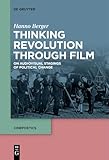Thinking Revolution Through Film : On Audiovisual Stagings of Political Change / Hanno Berger.
Material type: TextSeries: Cinepoetics – English edition ; 10Publisher: Berlin ; Boston : De Gruyter, [2022]Copyright date: ©2022Description: 1 online resource (X, 223 p.)Content type:
TextSeries: Cinepoetics – English edition ; 10Publisher: Berlin ; Boston : De Gruyter, [2022]Copyright date: ©2022Description: 1 online resource (X, 223 p.)Content type: - 9783110753752
- 9783110754735
- 9783110754704
- 791.436
- online - DeGruyter
- Issued also in print.
| Item type | Current library | Call number | URL | Status | Notes | Barcode | |
|---|---|---|---|---|---|---|---|
 eBook
eBook
|
Biblioteca "Angelicum" Pont. Univ. S.Tommaso d'Aquino Nuvola online | online - DeGruyter (Browse shelf(Opens below)) | Online access | Not for loan (Accesso limitato) | Accesso per gli utenti autorizzati / Access for authorized users | (dgr)9783110754704 |
Browsing Biblioteca "Angelicum" Pont. Univ. S.Tommaso d'Aquino shelves, Shelving location: Nuvola online Close shelf browser (Hides shelf browser)

|

|

|

|

|

|

|
||
| online - DeGruyter Making an Entrance : Appearing on the Stage from Racine to Nietzsche / | online - DeGruyter The Lawyer in Dickens / | online - DeGruyter Alexandra : Griechisch – deutsch / | online - DeGruyter Thinking Revolution Through Film : On Audiovisual Stagings of Political Change / | online - DeGruyter Erzählte Oratorik : Politische Rede in der deutschsprachigen Literatur des Spätmittelalters / | online - DeGruyter E-Learning : Digitale Lehr- und Lernangebote in Zeiten von Smart Devices und Online-Lehre / | online - DeGruyter Fibelausstattung und Lebensalter in der Merowingerzeit : Studien zu Abnutzung und Gebrauch frühmittelalterlicher Fibeln / |
Frontmatter -- Acknowledgments -- Contents -- 1 Introduction -- 2 The Theory of Revolution: Prolegomena -- 3 The “Machine Which Thinks Temporally” -- 4 NAPOLÉON: The Sublime Conceptualization of Revolution -- 5 REDS: The Russian Revolution in Hollywood -- 6 JOHN ADAMS: Before the Birth Comes the Revolution -- 7 Conclusion -- Bibliography -- Filmography -- Name Index -- Film Index
restricted access online access with authorization star
http://purl.org/coar/access_right/c_16ec
This book aims to redefine the relationship between film and revolution. Starting with Hannah Arendt’s thoughts on the American and French Revolution, it argues that, from a theoretical perspective, revolutions can be understood as describing a relationship between time and movement and that ultimately the spectators and not the actors in a revolution decide its outcome. Focusing on the concepts of ‘time,’ ‘movement,’ and ‘spectators,’ this study develops an understanding of film not as a medium of agitation but as a way of thinking that relates to the idea of historicity that opened up with the American and French Revolution, a way of thinking that can expand our very notion of revolution. The book explores this expansion through an analysis of three audiovisual stagings of revolution: Abel Gance’s epic on the French Revolution Napoléon, Warren Beatty’s essay on the Russian Revolution Reds, and the miniseries John Adams about the American Revolution. The author thereby offers a fresh take on the questions of revolution and historicity from the perspective of film studies.
Issued also in print.
Mode of access: Internet via World Wide Web.
In English.
Description based on online resource; title from PDF title page (publisher's Web site, viewed 25. Jun 2024)


